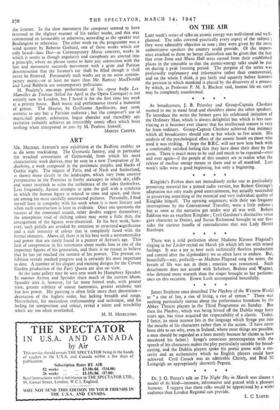ART
MR. MICHAEL AYRTON'S new exhibition at the Redfern enable; us to do some stocktaking. The Germanic fantasy, and in particular the wracked contortions of Griinewald, from which his most characteristic work derives, may be seen in a new Temptation of Sr. Anthony, a work composed in the passionate purples and blacks of Gothic night. The impact of Paris, and of Nash and Sutherland, is shown more clearly in the landscapes, which vary from emotive perspectives in the Potteries to frothy seascapes in which sky, cliffs and water interlock to echo the turbulence of the tides themselves. Less frequently, Ayrton attempts to span the gulf with a synthesis in which the human figure is related to time and space, and these are among his most carefully constructed pictures. Personally, I find myself least in sympathy with his work when it is most literary and when such construction is least in evidence. Once one questions the success of the emotional assault, other doubts suggest themselves ; the amorphous void of shifting colour may seem a little thin, the arrangement of the figures over-theatrical. In his best work, how- ever, such pitfalls are avoided by attention to structural .significance and a rich intensity of colour that is completely fused with the formal elements. Above all, there is in his best work a monumentality and power that are rarely found in a painter of Ayrton's age. This lack of compromise in his statements alone marks him as one of the important figures of his generation, and there is no reason to believe that he has yet reached the summit of his powers. The present ex- hibition reveals marked progress and is certainly his most important to date. A number of his elegant and exciting designs for the Covent Garden production of the Fairy Queen are also on view.
At the same gallery may be seen new work by Humphrey Spender. In manner Ayrton and Spender share much of the current idiom. Spender uses it, however, for far more formal ends, with greater taste, greater subtlety of colour harmonics, greater aesthetic tact but less power. His painting is often little more than decoration— decoration of the highest order, but lacking breadth and range. Nevertheless, his meticulous craftsmanship and technique, and his feeling for composition and colour, reveal a talent and sensibility which are too often overlooked.
M. H. MIDDLETON.


































 Previous page
Previous page